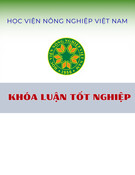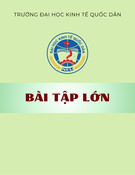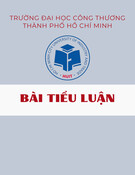
RESEARC H Open Access
Updated survivals and prognostic factor analysis
in myeloma treated by a staged approach use of
bortezomib/thalidomide/dexamethasone in
transplant eligible patients
Chor Sang Chim
Abstract
Background: Bortezomib, an NFkB inhibitor, is an active agent for the treatment of myeloma (MM). We have
reported a promising complete remission (CR) rate for newly diagnosed myeloma patients treated by a staged
approach, in which chemosensitive patients underwent autologous haematopoietic stem cell transplantation (auto-
HSCT) while less chemosensitive patients received salvage therapy with bortezomib/thalidomide/dexamethasone
prior to auto-HSCT.
Methods: Herein, with an additional 13 months of follow-up, we reported the updated survivals, and examined
potential prognostic factors impacting event-free (EFS) and overall survival (OS).
Results: With a median follow-up of 30 months, the projected OS was 73% and EFS was 50.2%. Age, gender,
clinical stage and DAPK methylation could not account for the differential chemosensitivity. Advanced ISS stage
and DAPK methylation adversely impacted OS whereas oligoclonal reconstitution predicted superior EFS.
Conclusions: Our staged approach illustrated an economical use of expensive targeted agents while preserving a
good CR rate and OS. The comparable survivals of chemosensitive and less chemosensitive patients suggested the
staged approach might have abolished the adverse prognostic impact of suboptimal chemosensitivity. Finally, the
adverse impact of DAPK methylation and favorable impact of oligoclonal reconstitution in myeloma warrants
further study.
Background
Bortezomib, an NFkB inhibitor, is an active agent for the
treatment of myeloma (MM). After the demonstration
of its efficacy as salvage therapy in chemo-resistant or
refractory myeloma patients with a CR rate of 9% [1,2].
a high CR rate has also been demonstrated when borte-
zomib was used in induction therapy in newly diagnosed
myeloma patients. For instance, a CR rate of 43% and
30% was observed when bortezomib-based induction
therapy was applied in both transplant-eligible and
transplant-ineligible myeloma patients [3,4].
In Hong Kong, we have adopted a staged approach, in
which newly diagnosed, transplant-eligible myeloma
patients were risk-stratified according to their initial che-
mosensitivity, wherein VAD-chemosensitive patients
underwent autologous hematopoietic stem cell transplanta-
tion (auto-HSCT) while less VAD-chemosensitive patients
received salvage therapy of bortezomib/thalidomide/dexa-
methasone (VTD) before auto-HSCT.
5
(Figure1)Wehave
reported frequent occurrence of oligoclonal reconstitution,
frequent central nervous system myeloma (one with lepto-
meningeal myeloma presenting with diplopia, and the
other with intraspinal plasmacytoma causing spinal cord
compression) and absence of thalidomide-related deep-
vein thrombosis despite no prophylaxis with either aspirin,
low molecular weight heparin or warfarin [5]. In addition,
at a median follow-up time of 17 months, we have reported
an overall CR rate of 48% (by an intention-to-treat analy-
sis), and a 3-year OS and 75% [5]. Based on this approach,
Correspondence: jcschim@hku.hk
Department of Medicine, Queen Mary Hospital, University of Hong Kong,
Hong Kong
Chim Journal of Translational Medicine 2010, 8:124
http://www.translational-medicine.com/content/8/1/124
© 2010 Chim; licensee BioMed Central Ltd. This is an Open Access article distributed under the terms of the Creative Commons
Attribution License (http://creativecommons.org/licenses/by/2.0), which permits unrestricted use, distribution, and reproduction in
any medium, provided the original work is properly cited.

only 56% myeloma patients required salvage therapy with
VTD. Herein, with an extended follow-up (median: 30
months, range: 7-54 months), we reported the updated sur-
vivals. In particular, we examined if diagnostic clinical
parameters might account for the differential VAD chemo-
sensitivity. Moreover, potential risk factors for EFS and OS,
including methylation of Death-associated Protein Kinase
(DAPK) and the development of oligoclonal reconstitution,
were analysed.
Methods
Treatment
The study started in early 2005 and ended in late 2008.
The median follow-up time was 30 months (range: 7 - 54
months). Details of the trial has been reported [5]. In brief,
25 newly diagnosed, symptomatic MM with younger than
65 years with measurable disease were enrolled. All
patients received initial cytoreduction with three cycles of
VAD (vincristine, adriamycin and dexamethasone). Those
achieving ≥75% reduction in paraprotein, i.e. VAD-che-
mosensitive patients, proceeded to auto-HSCT. Patients
with <75% reduction in paraprotein, i.e. less chemosensi-
tive subgroup, received salvage therapy with four cycles of
VTD (bortezomib: 1.3 mg/m
2
/day intravenously on days 1,
4, 8 and 11; thalidomide: 200 mg/day; dexamethasone:
40 mg/d orally from days 1-4 and days 8-11). After VAD
induction therapy, fourteen (56%) patients required VTD
salvage therapy. Auto-HSCT conditioning regimen com-
prised intravenous melphalan at 200 mg/m
2
. All patients
received thalidomide (100-200 mg/day) as maintenance
therapy regardless of whether VTD had been used. The
protocol was approved by the institution review board in
accordance with the Declaration of Helsinki, and informed
consent was obtained from all participating patients. The
treatment algorithm was shown in Figure 1.
Monitoring of response
All patients were analyzed on an intention-to-treat basis.
Progression was defined as ≥25% paraprotein increase in
two consecutive tests four weeks apart. Relapse was
defined as reappearance of the paraprotein on immuno-
fixation in CR patients, positive SPE in the nCR patients,
and/or appearance of new bone lesions. Oligoclonal
reconstitution, defined as the appearance of a new para-
protein persisting for ≥4 weeks, was demonstrated in six
patients [5]. Three patients with light chain myeloma
developed a IgG paraprotein (two IgG/kappa from free
kappa, one IgG/lambda from free lambda). One devel-
oped a double IgG/kappa from a single IgG/kappa, and
two patients had complete change of paraprotein (one
from IgA/kappa to IgG kappa, and one from IgD/lambda
to IgG/kappa).
Statistical analysis
OS was defined as time from commencement of induction
therapy to death or last follow-up. Event-free survival
(EFS) was defined as time from commencement of induc-
tion therapy to the date of progression, relapse or death.
Survival curves were plotted by Kaplan-Meier method.
Prognostic factors including age, gender, international sta-
ging system (ISS) [6]. DAPK methylation status and
achievement of CR after auto-HSCT were studied for their
impact on survival by univariate analysis. Survival curves
were plotted by Kaplan-Meier method and compared by
the log-rank test [7]. Moreover, to see if early PR after one
cycle of VAD might predict subsequent need of VTD
VTD
Salvage
(n=14)
Autologous
HSCT
(n=21)
VAD
(n=25)
RESPONSE
t
75%
(n=11)
Chemo-
sensitive
Low-Risk
Less
chemo-sensitive
<75%
(n=14)
High-Risk
Figure 1 Treatment algorithm of the staged approach for newly diagnosed, symptomatic myeloma patients.
Chim Journal of Translational Medicine 2010, 8:124
http://www.translational-medicine.com/content/8/1/124
Page 2 of 7

salvage therapy, achievement of PR, i.e >50% reduction in
paraprotein, after one cycle of VAD was correlated with
subsequent need of VTD salvage upon completion of
three cycles of VAD by Chi-Square test.
Methylation study
Methylation-specific polymerase chain reaction (MSP)
for aberrant promoter methylation was performed as pre-
viously described [8-10]. Treatment of DNA with bisul-
phite for conversion of unmethylated cytosine to uracil
(but unaffecting methylated cytosine) was performed
with a commercially available kit (CpGenome DNA mod-
ification kit, Intergen, New York). The primers for the
methylated (M-MSP) and unmethylated (U-MSP) pro-
moters of DAPK has been previously described [10-12].
Results
The projected 4-year OS was 73.7%, the 4-year EFS
was 50.2% with a median follow-up time of 30 months.
(Figure 2)
Comparing the VAD-chemosensitive with the less
chemosensitive subgroups, there was no significant dif-
ference in the median age and distribution of gender,
paraprotein subtypes and International Stage. (Table 1)
Of the 22 patients with methylation study data, four
(18.2%) carried DAPK methylation. However, the pro-
portion of patients carrying DAPK methylation or devel-
oping oligoclonal reconstitution was not different. On
the other hand, more chemosensitive patients (90.9%)
achieved ≥VGPR after auto-HSCT than those less che-
mosensitive patients (p = 0.03). The projected EFS were
51.1% for chemosensitive, and 49.2% for less chemosen-
sitive patients (p = 0.974)(Table 2). The projected OS
was 71.6% and 76.0% for chemosensitive and less che-
mosensitive patients (p = 0.887) (Figure 3) (Table 2).
Of the 23 patients with response data after one cycle
of VAD, 11 (48.8%) fail to achieve PR. Of these, 10
(90.9%) finally required VTD salvage therapy as the cul-
mulative response after three cycles of VAD was <75%
paraprotein reduction. (p < 0.001)
Analysis of risk factors for survivals showed that only
advanced ISS (0.034) (Figure 4) and DAPK methylation
(p = 0.02) (Figure 5) predicted inferior OS but not EFS.
A
B
Figure 2 (A) Updated Overall survival (OS) and (B) Event-free
survival (EFS) for the whole group.
Table 1 Differences between VAD-chemosensitive (CS)
and less VAD-chemosensitive (LCS) patients
CS [%] LCS [%] P-value
Gender 0.99
Male 7 [63.6] 10 [71.4]
female 4 [36.4] 4 [28.6]
Age (median) 49 55 0.217
paraprotein subtype 0.07
G 3 [27.3] 9 [64.3]
A 1 [9.1] 3 [21.4]
D 2 [18.2] 0 [0]
LC 5 [45.5] 2 [14.3]
ISS stage 0.69
I & II 7 [63.6] 7 [50]
III 4 [36.4] 7 [50]
≥VGPR after induction 0.227
No 3 [27.3] 8 [57.1]
Yes 8 [72.7] 6 [42.9]
≥VGPR after ABMT 0.03
No 1 [9.1] 7 [50.0]
Yes 10 [90.9] 7 [50.0]
Oligoclonal reconstitution 0.434
Yes 5 [45.5] 4 [28.6]
no 6 [54.5] 10 [71.4]
DAPK methylation 0.216
methylated 3 [27.3] 1 [7.1]
unmethylated 6 [54.5] 12 [85.7]
unknown 2 [18.2] 1 [7.1]1
G: IgG; A: IgA; D: IgD; LC: light chain myeloma; DS: Durie-Salmon stage; ISS:
International staging system; VGPR: >90% reduction in paraprotein level.
Chim Journal of Translational Medicine 2010, 8:124
http://www.translational-medicine.com/content/8/1/124
Page 3 of 7

On the other hand, development of oligoclonal reconsti-
tution predicted superior EFS but not OS. (Figure 6)
However, age, gender, VAD-sensitivity, attainment of
≥VGPR after induction therapy and achievement of
≥VGPR after auto-HSCT did not impact either EFS
or OS. (Table 2)
Discussion
This extended follow-up study revealed a EFS and an
OS comparable to another study using bortezomib/
adriamcyin/dexamethasone (PAD) regimen as frontline
therapy in newly diagnosed myeloma, in which the
median EFS was 29 months, and the 4-year OS was
73% [3]. However, in our study, only 56% patients
required the use of bortezomib-based salvage therapy.
Therefore, this staged approach will carry significant
impact on healthcare financing systems in less affluent
countries. For instance, had all our patients been trea-
ted with four cycles of VTD upfront prior to auto-
HSCT (with four injections of bortezomib on days 1,
4, 8 and 11 in each cycle, costing USD4800 per cycle),
then an additional 11 patients (i.e. those failing to
achieve ≥75% reduction in paraprotein level) would
have required four cycles of bortezomib, and hence an
additional cost of USD211,200.
Moreover, to see if early PR after one cycle of VAD
may predict subsequent need of VTD salvage therapy,
achievement of PR (i.e >50% reduction in paraprotein)
after one cycle of VAD was correlated with subsequent
need of VTD salvage after three cycles of VAD by Chi-
Square test. Of the 23 patients with response data after
one cycle of VAD, 11 (48.8%) fail to achieve PR. Of
these, 10 (90.9%) finally required VTD salvage therapy
as the culmulative response after three cycles of VAD
was <75% paraprotein reduction. (p < 0.001) Therefore,
patients who failed to achieve >75% paraprotein reduc-
tion, and hence ultimately require VTD salvage, could
in fact be predicted by the ability to achievev a PR after
one cycle of VAD, which would reduce the incidence or
severity of sensory neuropathy associated with the sub-
sequent use of VTD.
Our approach was based on risk-stratification by
initial VAD-chemosensitivity. Therefore, we studied if
the differential VAD-chemosensitivity might be asso-
ciated with favorable risk factors, and hence attributable
to the clinical parameters including age, gender, DS and
ISS stage. However, no difference was demonstrated in
the distribution of these risk factors in the chemosensi-
tive and less chemosensitive patients. On the other
hand, DNA methylation may be an important biomarker
[7,13-15]. In particular, methylation of DAPK,atumor
suppressor gene, has been analyzed. However, there was
Table 2 P-values for univariate analysis of prognostic
factors
OS EFS
Gender 0.081 0.211
Age (median) 0.828 0.770
Paraprotein subtype 0.382 0.393
ISS 0.026 0.645
VAD chemosensitivity 0.887 0.974
VGPR after induction 0.722 0.406
VGPR after auto-HSCT 0.181 0.357
Oligoclonal reconstitution 0.170 0.039
DAPK methylation 0.029 0.136
DS: Durie-Salmon stage; ISS: International staging system; VGPR: >90%
reduction in paraprotein level; OS: overall survival; EFS: event-free survival.
A
P=0.974
OS (months)
B
P=0.887
EFS (months)
Figure 3 (A) OS and (B) EFS of VAD-chemosensitive (green line)
and less chemosensitive (blue line) patients, showing
comparable OS and EFS in VAD-chemosensitive and less
chemosensitive patients.
Chim Journal of Translational Medicine 2010, 8:124
http://www.translational-medicine.com/content/8/1/124
Page 4 of 7

no difference in the proportion of patients with DAPK
methylation. Therefore, neither clinical parameters nor
DAPK methylation could account for the differential
VAD chemosensitivity.
As chemosensitivity is an important risk factor for
survival, we postulated that the higher chemosensitivity
might indeed translate into superior EFS and OS. How-
ever, there was no difference in the median EFS and OS
between the chemosensitive and less chemosensitive
subgroups, implying that the potential adverse prognos-
tic impact of suboptimal chemosensitivity has been abol-
ished by salvage therapy with the VTD regimen.
Figure 4 Impact of advanced (green line) and limited ISS stage (blue line) on OS, showing inferior survival in patients with advanced
ISS stage.
Figure 5 Impact of the presence (green line) and absence of (blue line) DAPK methylation on OS, showing inferior survival in patients
with DAPK methylation.
Chim Journal of Translational Medicine 2010, 8:124
http://www.translational-medicine.com/content/8/1/124
Page 5 of 7

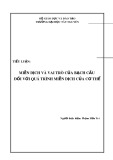
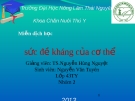

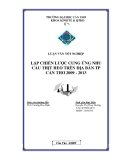
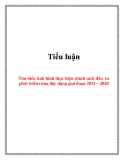
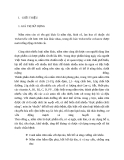
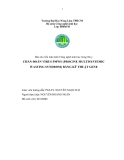
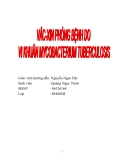
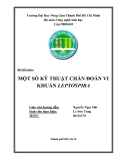
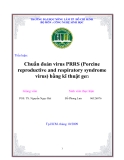

![Bệnh Leptospirosis: Khóa luận tốt nghiệp [Nghiên cứu mới nhất]](https://cdn.tailieu.vn/images/document/thumbnail/2025/20250827/fansubet/135x160/63991756280412.jpg)


